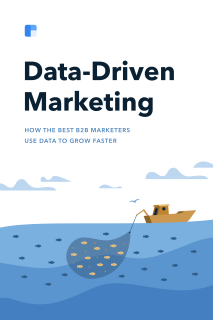Chapter 9
19 minutes
Competitive Marketing

Brianne Kimmel Founder at Worklife Ventures
It may sound controversial, but it’s important to love your competition. Competition is a great sign in a startup’s early days because it validates the market and, as the company grows, challengers keep it from getting too comfortable.
I’ve spent most of my career facing tough competition. In the early days, I helped build an online community and e-commerce platform for Nikon, battling its longtime competitor Canon—and, later, hip disruptors in the camera world like Leica and the iPhone. At Expedia, I focused on customer acquisition and international growth. Expedia Inc. and Priceline Group, with their respective portfolio companies, are the two global players in the incredibly competitive online travel agency world.
In environments like these, you have to watch your competition closely and make strategic moves to steal market share. Quick wins can come from price cuts and feature wars, but true defensibility is a long-term game.
When I joined Zendesk, competitive marketing was taboo.
It was crucial at first to stay focused on building a great product and growing our customer base, as it is for any startup. You don’t want to get distracted by every move that a competitor makes. (In Zendesk’s case, launching a disruptive product in 2007 meant you could have a little fun with the competition. The team created Zendesk Alternative, a fake punk rock band, to disrupt our competitors’ paid search strategy—and their landing pages’ ranking for “Zendesk Alternative.”)
Today, we see a very different competitive landscape. With open-source technology, it’s never been easier to start a company. This means that there’s a new breed of competition that’s well funded and ready to steal market share. Companies are forced to play offense and defense as they push to move up market.
Traditionally, we think competitive marketing only applies to big challenger brands: Coca-Cola versus Pepsi, Chevy versus Ford, etc. There are also brand campaigns like the Lyft campaign mocking Uber in a high-stakes match to gain control over the rideshare market. But that’s just one side of competitive marketing.
B2B SaaS companies also have sustained, systematized, and data-driven competitive marketing in their arsenal to defend their positions.
In this chapter, I’ll share personal learnings and best practices on competitive marketing.
In this chapter, I’ll share personal learnings and best practices on competitive marketing.
- How to build internal consensus when creating a new discipline
- How to construct new competitive cohorts and win back opportunities lost
- Best practices for designing successful competitive marketing campaigns
- Goal setting and measurement for competitive marketing
Ready? Let’s get started by talking about building consensus to embrace competitive marketing.
Our shift to a competitive marketing mindset
Launching our first competitive marketing campaign required internal buy-in. It was a complete shift in strategy, so I worked closely with our head of design, Ryan Donahue, to lead a cross-functional design thinking session.
“Our competitive brand needed to claim our corner of the market: to show what Zendesk stands for, who we serve, and how we do it better than competitors,” says Ryan. “The right positioning came to light with some holistic thinking and buy-in from our marketing and sales teams. Marketing provided insights and high-level research, and sales provided qualitative observations from recent wins.”
During the session, one insight clarified our approach and became the cornerstone of our new philosophy: We have the highest CSAT score of our industry. It’s better for the consumer if they pick Zendesk, and we’re doing them a disservice if they choose a low-end product, dislike it, and come back to us 6–12 months later.
After all, we could offer scale. Scale is a major challenge for low-end, copycat competitors. Customers quickly outgrow the product and end up with a painful migration or rip-and-replace later. We looked at our historical data and found what we call our “boomerangs”: the number of opportunities we lost that organically came back to Zendesk.
We used this boomerang data to show the team that competition isn’t really about Zendesk versus a competitor. It’s actually about empowering potential customers to invest up front and choose a partner that can scale. We need to be better communicators now, so that people are informed to make a smart decision sooner rather than later. This helped us build internal consensus.
And there was another key insight: We have “frenemies.”
One of Zendesk’s core differentiators is that we provide a seamless integration to a customer’s existing tech stack. We have 600+ apps in our Apps Marketplace (Salesforce, Jira, Microsoft and Slack, to name a few), many of which offer products that compete with a tool in the Zendesk suite. To successfully build these integrations, we need strong relationships with our frenemies.
In the end, we didn’t want to be a total asshole when it came to competition marketing. So the resulting brief was simple:
Zendesk has a 95% CSAT score and over 100,000 customers. How do we demonstrate our relationship and ability to scale to people who are actively searching for software in our category?
As we took that brief and started to design competitive campaigns and creatives, we pulled together our team. Competitive marketing at Zendesk is a strong partnership across many parts of the organization.
- Product marketing goes deep on competitive insights to understand product, pricing, and win-loss data. Responsibilities include creating competitor-specific playbooks and battlecards, sales training and enablement, and in-depth win/loss reporting.
- Growth uses a number of data sources to mine for important cohorts. They do competitive cohort building, competitive landing page tests, and paid media strategy.
- Lifecycle marketing runs winback campaigns (email and direct mail), and builds personalized nurtures for competitive product users.
- Creative and content develops and tests creative assets, including brand campaigns and direct response materials.
Once we had a brief and a team in place, we realized that Zendesk competes in multiple markets, and that we’d need a slightly different approach for each.
How we approach different customer tiers
Traditionally, Zendesk’s sweet spot has been self-serve velocity to mid-market companies.
But the company has started to move upmarket, so competitive marketing distinguishes between different customer tiers and approaches them differently.
Startups — We view startups as a clean slate from a competitive standpoint. We provide free or discounted software and partner with top incubators and accelerators to grow this line of business.
Self-serve — We use competitive landing pages to intercept search traffic and work with review sites like G2 Crowd and Quora. We also offer migration guides to help people make the switch.
Sales-assisted midmarket and enterprise — These are our more upmarket customers that interface with Zendesk’s sales team closely. Educating sales and using traditional competitive strategies come into play here, including battle cards, sales enablement collateral, and an RFP process. A big focus of the growth team is owning the bottom-of-funnel experience. We offer a vendor evaluation cheat sheet and valuable content pieces like our Customer Service Benchmark report
| Market | Approach |
|---|---|
| Startups | Dedicated programs, discounted software, and partnerships with top incubators and accelerators |
| Self-serve | Competitive landing pages and content, migration guides, and review sites |
| Midmarket / enterprise | Sales collateral and content, battle cards, and RFP proccesses |
Because Zendesk’s competitive marketing targets high-volume audiences across multiple markets, a quantitative, automated approach to audience building and outbound marketing is absolutely necessary. It helps our marketing team scale.
That said, as we move upmarket and proactively approach target accounts, we plan to take a more qualitative approach and develop personalized campaigns.
Twilio’s competitive marketing efforts are a great example of more personalized competitive marketing. Clair Byrd, Twilio’s head of competitive marketing, focuses on brand-oriented, high-touch video series, customer stories, and sales-enablement collateral. We invest in high-quality brand campaigns too, but when it comes to competitive marketing, we’ve simplified our creatives and taken a more direct response approach.
 Twilio’s Airbnb case study video
Twilio’s Airbnb case study video
I’ve just shared a little about Zendesk’s rationale for competitive marketing, how we put together our team, and how we change our strategy depending on the size of customer we’re targeting. Now let’s get into some tactics, starting with outbound email campaigns.
Examples of our competitive outbound campaigns
For competitive user acquisition, context and timing are key. We use a number of data sources and APIs to identify prospects that use competing products and send them a highly personalized message at the right time, automatically. Clearbit tech tags show us a prospect’s tech stack, so in the email, we can tell them exactly how Zendesk will integrate and why they should switch from their current software.
Before running outbound email campaigns, we need to iron out our contact list.
How we segment our competitive audience list
When we think of our available list for competitive marketing, we divide it into three groups.
(This is different from our earlier divisions among startups, self-serve, midmarket, and enterprise companies. It’s more about organizing our contactable universe.)
List 1: Open deals that are ready to close. These folks are actively considering Zendesk, and they’re in touch with our sales team. We arm sales with internal training and collateral, such as guides to switching and vendor evaluation cheat sheets.
From a marketing perspective, we take a more personalized approach with our open deals. A strong partnership between Growth and Field Marketing has worked well for this audience. Both teams have a shared goal and campaign theme, which creates a cohesive experience across digital, direct mail, and regional field events.
List 2: Closed-lost. These are companies that were once in our open deals bucket and we lost them to our competitors. We send automated winback emails that communicate about pain points that customers of our competitors typically experience, as well as personalized touches, such as invites to regional events.
List 3: Net-new competitive contacts. These contacts are new to Zendesk and sourced through a number of data providers. This cohort has the largest audience size, but these opportunities take a longer time to close. Once we identify a competitive product’s user who is visiting our site, we add them to a personalized experience based on the solution they’re currently using.
Let’s take a closer look at an automated winback campaign we run for list #2.
Winback email campaigns
Once an account executive marks an opportunity as lost, the contact gets added to a dedicated nurture funnel. We want to provide highly relevant information to help companies grow, even if they chose a competitive product. Tools like the Zendesk Benchmark, which gives organizations a way to measure their customer service performance against their peers, are a great way to add informational value in ways that our competitors can’t.
Building winback cohorts takes some work on the data enrichment side. Opportunity closed-lost data can quickly become outdated when a contact leaves the company or changes roles. We use Clearbit to enrich company-level data and get fresh contact-level data—including a company’s industry, size, job titles of key players, and more. We also look at tech tags that show us what other tools are in the company’s tech stack.
Our first action is to send a highly personalized, automated check-in email. We speak to specific pain points that companies experience with a competitor and why they proactively come to Zendesk.
We do research to find out which pain points to highlight by using tools like our Techvalidate surveys, which we’ll talk about toward the end of the chapter.
This personalized winback email campaign is automated so that people on the list get the message after six months (or whatever timeframe we’re testing). To track how effective our winback outbound is, we measure winback rate and pipeline.
We also have a highly personalized email campaign for list #3: net-new competitive contacts.
Outbound emails to net-new contacts
We want to introduce Zendesk to brand-new users who aren’t on our radar yet, but “cold emails” are a thing of the past. We call these “personalized first touches.”
Here’s how we spin up our net-new contact list. (Remember that we didn’t need to do this for winback emails, because that list came from sales’ closed-lost opportunities.)
Step 1: Build a target company list
We want this list to be large and marketable, and we aim for it to be 3–5 times larger than our closed-lost list.
We use multiple data sources to build highly qualified contact lists.
-
Real-time search data: G2 Crowd identifies companies that are searching for software in our category and provides the frequency of page visits.
-
Technographic data: HG Data identifies backend technology installs to identify competitive product users at the company level.
-
Intent data sources: Bombora is an intent data source that creates an intent score based on people who are looking for customer support software or reading about “customer experience” and “customer relationships.”
Step 2: Enrich company list for relevant contacts
The next step is to identify relevant contacts within the target company.
We pass data to Clearbit for enrichment so we can identify multiple decision makers within the target company for a multi-touch entry strategy. Then, we enrich the contacts to get detailed contextual data that inform the content of our personalized first-touch emails.
Step 3: Personalize outbound emails
We create email creatives with custom fields where we can plug in different information based on Clearbit data about the recipient.
For example:
- Use Tech Tag data to understand and reference the tools that currently drive their business.
- Use Industry data to include relevant logos and customer stories based on the recipient’s industry.
- Use Company Size data to qualify the recipient as self-serve or sales-assisted, and change the CTA accordingly. The CTA for self-serve might offer an on-demand demo or free trial, whereas a sales-assisted customer gets a Calendly link to schedule a meeting with sales.
You can also apply these data signals to your current customer base to identify expansion opportunities or companies at risk of churn. For example, by identifying when a competitive tech tag is installed, you can engage with customers before they churn.
After nailing down our automated outreach systems, it’s time to plug in customized, competitive creatives.
Creative and messaging for competitive campaigns
It’s helpful to understand the emotional hurdles that come with switching software solutions.
- Time: Is switching solutions really worth my time? What is the ROI of switching?
- Credibility: Will my manager and stakeholders be happy with this switch?
- Comfort/complacency: My current solution is “good enough,” so why should I switch?
When it comes to competitive campaigns, you need to get to the punchline quickly. Often companies use feature comparisons or ROI metrics to hook competitive product users quickly. I often refer to Darius Contractor’s Psych Framework to help us focus on key data points and remove fluff.
Darius Contractor leads growth and engineering teams for Dropbox. His organization runs A/B tests across the site to increase activation and revenue. He uses the Psych framework to verbalize his intuition about what should and shouldn’t make it onto their page designs and signup flows.
The Psych framework thinks of each UX interaction as an emotional event and assigns a number to it. An image might add +5 “psych” (in other words, excitement), while an extra signup form field might detract a little: -3 psych. It’s an attempt to “quantify a gut feel” and compare the excitement or effort that various UX interactions can generate.
Whereas most UX optimizations focus on removing unnecessary friction from a landing page, the Psych framework also places importance on the positive side: a user’s excitement is the fuel that’ll propel them through any friction the flow might have. In other words, fill the gas tank before you use the car.
This framework helps marketers and designers understand what’s going on in marketing materials, emails, sites, and flows, and helps generate test ideas.
Psych helped the Dropbox team uncover a key insight about B2B purchasers.
B2B SaaS customers are a high-intent audience, and they want to know what they’re getting. Therefore, quickly providing information to these buyers adds psych and propels them through a flow.
“A lot of people in growth want to keep it low-emotion, focus on removing friction, and pare down information,” says Darius. “But in a B2B context, we’ve learned that Dropbox has high-intent and high-knowledge users. They may have used Dropbox for years as a consumer. So when they switch to purchasing for business, they just want to know what they’re getting. Information provides clarity that increases psych.”
For instance, one Dropbox Business test moved the page’s Pricing link into the prime spot of first link on the navigation menu. It used to be two links to the right, which is more standard for a landing page like this.
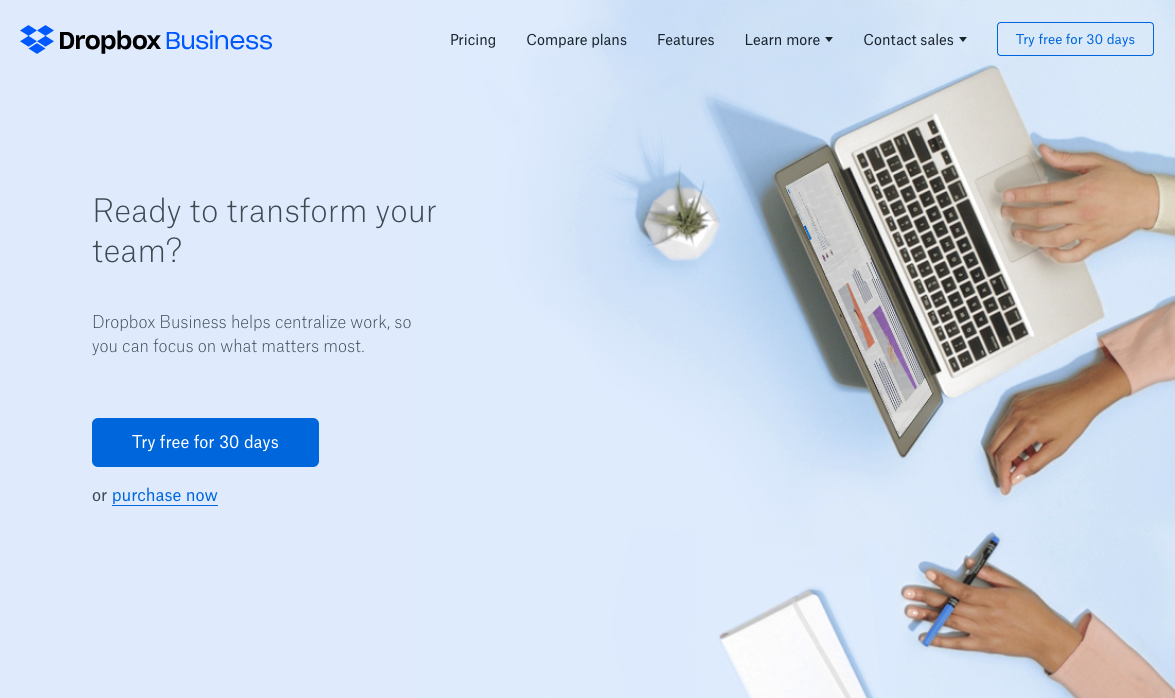
Placing the pricing link first resulted in more people starting trials, presumably because it more readily surfaces decision-making information. People are searching for clarity about exactly what they’d get with Dropbox for business; they can click the prominent link, see that the pricing is reasonable, notice they’ll get all the features they need, and get started.
In another example, Dropbox changed the default CTA button text from “Try Free” to “Try free for 30 days.” Typical wisdom about removing UX friction might say that “for 30 days” is a longer string, and adds complexity and distraction. But it was actually much more effective. There are many possible reasons for this, but the Psych framework posits that giving the B2B user more information adds positive energy and converts them more successfully than just sending them to a form as quickly as possible.
We’ve found that the same is true for competitive Zendesk creatives, where we’re talking to buyers who have high knowledge and intent, so we provide plenty of features, comparisons, and key stats.
How we track metrics and monitor the competition
Our competitive marketing operations hinge on our ability to track metrics and to keep an eye on the competition. Every week we review competitive insights and metrics, and we also hold office hours.
Competitive marketing metrics
Key metrics for competitive marketing include:
- Pipeline creation: first/last touch from competitive product users
- Win/loss rate
- Churn rate
- Average time to close
Secondary metrics from enrichment data:
- Competitive product installs
- Target account wins
Competitive insights
For a B2B SaaS company, it’s possible to have partners, competitors, and frenemies. Companies come with a number of existing tools, so it’s important to have seamless integration with existing technologies.
Hiten Shah has a helpful framework for competitive analysis that splits competitors into four buckets.
- Direct competitors (low end and aspirational) - Direct competitors build a software product or service, similar to yours, that solves the same problem for the same prospects.
- Indirect competitors - These serve the same prospects but offer different features than you do.
- Alternative solutions - These are alternatives to software products, like manual solutions (pen and paper solutions, Excel, etc.) or even hiring contractors to solve a problem.
- Multiple tool solutions - This is when customers solve their problem by stitching together multiple tools instead of choosing a single piece of software. Perhaps they use Zapier to automate a process and connect apps.
Competitive analysis and insight gathering is typically a highly cross-functional effort with few dedicated resources. Depending on the maturity of your competitive marketing program, there are a number of low- to high-touch intelligence tools you can try to power your competitive strategy.
Low touch
- Google Alerts - receive email alerts about competitors’ latest news
- SEMrush - generate reports on competitors’ search strategy
- CSAT - monitor ongoing customer satisfaction with surveys
Medium touch
- Crayon - receive automated reports on changes to competitors’ products, packaging, pricing, and landing pages
- G2 Crowd - monitor real-time search data for your business category
- TechValidate - run custom feedback surveys and collecting testimonials
High touch
- Original research - conduct internal user research, which can include reading qualitative data sources such as public competitor forums and communities like Quora. Tip: for startups or lean times, Ask Wonder is one way to outsource competitive research.
Let’s talk about TechValidate and Crayon a little more in depth, starting with TechValidate’s feedback surveys.
Feedback surveys are a great way to get detailed insights about users’ needs. Administer surveys during critical moments across the customer journey, such as after a successful on-board, six months into their contract with you, and one month before contract renewal.
In any win survey, the best way to gain a deeper understanding of where a user is coming from is to ask specific questions about the previous vendor, as shown in the following sample question. The resulting insights become core pillars for any competitive campaign messaging.
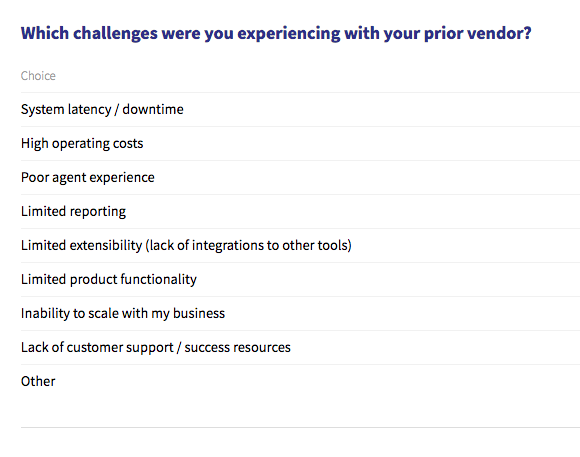
This TechValidate question asks respondents to prioritize purchase drivers:
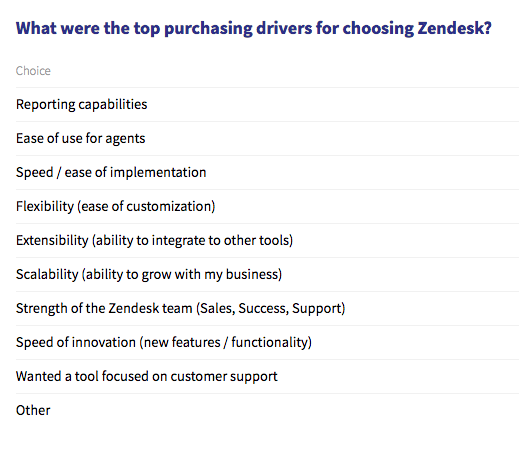
TechValidate also lets us collect validated testimonials from users. Here is a recent example from our Zendesk for Startups program survey.
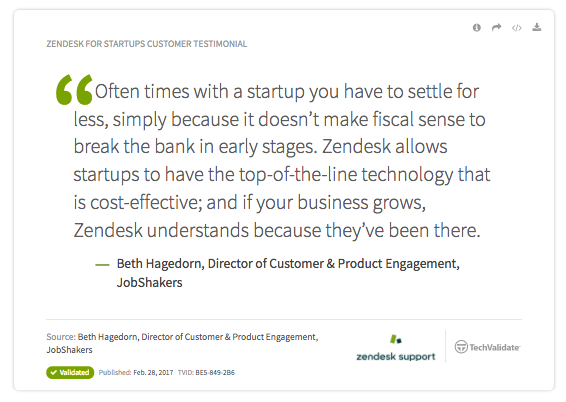
Crayon is another tool that’s become a pillar of our competitive analysis. It’s a secret weapon that provides rich competitive updates, like product and pricing changes and a dedicated competitive analyst.
For example, I might receive an alert from Crayon that shows how a competitor has recently tested a new CTA on a landing page.
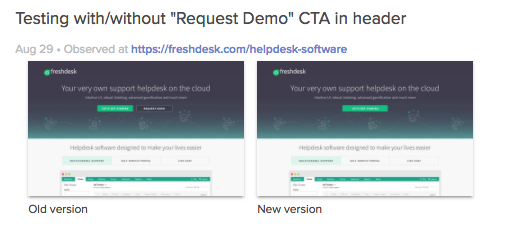
Or this alert that Freshdesk has added two new apps to their marketplace: Hotline.io and LiveChat.
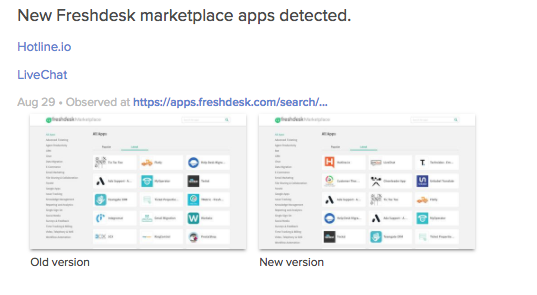
I’ve also created automated reports for our broader team to track our competitors, which I share via email and Slack. These updates have been personalized based on team and region, so insights are timely and relevant.
Final thoughts
Competitive marketing protects your company from new entrants, pushes you to communicate with prospects more effectively, and helps you win customers back. If you’re feeling shy about tackling competitors head on, try small experiments, and remember that there’s no need to fight dirty. You can design competitive creatives in a way that honors your brand.
And this is about more than just a big branding play. I’ve shared some highly effective competitive marketing strategies like private, personalized emails that stay out of the spotlight. This kind of personalization is key, because personalization forces you to study and acknowledge your recipients’ real needs and existing tech stack. You can pull this off at scale with a small team by using third-party data and automated workflows.
The last takeaway is to be vigilant. Review competitive metrics regularly while keeping an eye on the competition. There are many tools out there that can deliver intel to your team with little effort on your part. Do this well, and soon enough your competition will be studying you.
